Martello Tower

The Martello Tower at Magilligan Point, Limavady Grid reference C661388
|
The Martello Tower |

The Martello Tower at Magilligan Point, Limavady Grid reference C661388 |
|
In 1794 during the wars following
the French revolution, the British navy needed to capture a fortified
tower located on Point Mortella on the island of Corsica. This turned
out to be more difficult than expected, because the design of the tower
was rather sturdy. It was round and had very thick walls and had a flat
top with a gun that could point in all directions.
The troops on the tower held the ships at bay for two days, when they
were taken by a land based force.
When Napoleon Bonaparte, a former inhabitant of that very island, started to stir up trouble in Europe, Britain felt very vulnerable and the design and prowess of this Corsican tower was remembered and dozens of copies were built along the coasts of Kent and Sussex. Due to a characteristic linguistic mix-up the structures became known as Martello towers. By the end of the Napoleonic wars Martello towers had spread as far as the East Indies and Canada, and several were built in Ireland. Two magnificent examples cover the entrance to Lough Foyle. The Magilligan Martello tower was built towards the end of the wars in 1812 and is one of the most northerly of the towers built all around the coasts of Ireland. Originally a 24 pounder cannon was mounted on the top. It was fastened to a central pivot and moved on a circular rail so that it could point in all directions. The tower was built on top of a spring to ensure fresh water in case of a siege. Below the gun platform were the living quarters and the ground floor was used to store powder and ammunition. There is a similar tower in Greencastle, on the other side of Lough Foyle. 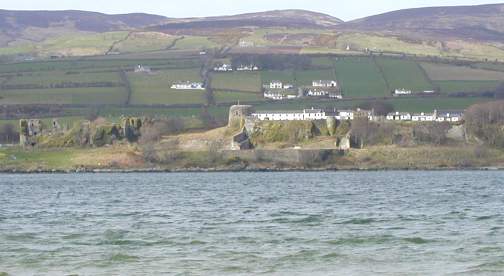
Martello Tower at Greencastle across Lough Foyle The dressed sandstone is from the Ballyharrigan quarries in Bovevagh and the building is a monument to the craftsmanship of Irish masons at the time. The wall of the tower is reputed to be eleven feet thick and the structure is well preserved, except for the entrance which is blocked for unspecified safety reasons. It stands in a beautiful location looking out to the Atlantic beyond the golden sands of Benone Strand and with a splendid view of Greencastle and the Donegal Hills on the other side of Lough Foyle. You might think that all this would make the spot a tourist paradise, but unfortunately this beautiful place is surrounded by an army shooting range and Magilligan jail, which make the drive to the tower a rather forbidding experience. At the moment a pier is being built at the point. It will link Greencastle and Magilligan within the year via a car ferry. This is very handy for the local tourist trade and it will save people from Limavady the 35 mile round-trip, as well as opening a completely new route to escaped non-swimming prisoners from the nearby jail. |
 Recently I have had a chance to
inspect the inside of the tower, which
is presently being restored to its former glory. Friendly workmen are
re-pointing the outside of the building,
removing the beginnings of a 'hanging garden' in the process, because
various weeds have started to colonize the walls of the tower.
Recently I have had a chance to
inspect the inside of the tower, which
is presently being restored to its former glory. Friendly workmen are
re-pointing the outside of the building,
removing the beginnings of a 'hanging garden' in the process, because
various weeds have started to colonize the walls of the tower.
I can vouch for the famous
thickness of the
brickwork, because the
spiral staircase that leads to the top, is actually built inside the
wall, just to the left of the entrance. On the 7th of July 2012 we celebrated the 200th anniversary of the Martello tower in Magilligan. This enabled me finally to have a good look around the inside of the tower - nicely lit by electric lights and also climb that staircase on the left to the very top.
Below are some of the photographs I took on that day. |
 |
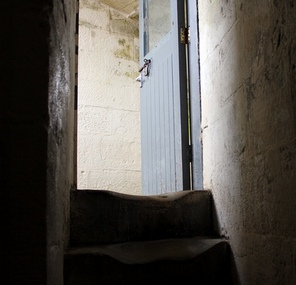 On the left is a rather nice cross-section of
a typical Martello Tower. As they all followed the same design, local
variations will have been minor. On the left is a rather nice cross-section of
a typical Martello Tower. As they all followed the same design, local
variations will have been minor.
The 24 pound gun is mounted at the top. It is held in place
by a central spike and can be turned full circle by running on two iron
rails. Below this are the living quarters for men and officers. The
ground floor was the storage area for powder, canon balls and various
kind of equipment and the cellar - where it was coolest - stored water
and food.
The picture on the right shows the top of the spiral staircase leading up to the roof. Notice the well-worn steps. Carting cannon balls up staircases obviously entails a lot of wear and tear. |

|
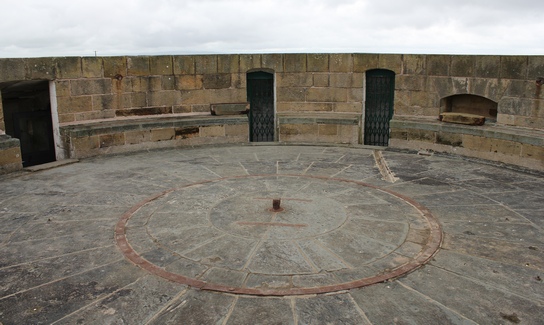 |
|
The
top of the tower. Notice the storage niches for the cannon balls and
the doorways to two small alcoves . These, I assume, were used to store the operational gunpowder.
The
gun rotated on two flat iron rails. The photograph on the right shows
the central rail quite clearly. The outer raised rail is best seen on
the left picture. Also notice what looks like two wooden logs lying on the ledge. These are removable sections of rail, which would have been fitted across the gaps left by the doorways. |
 |
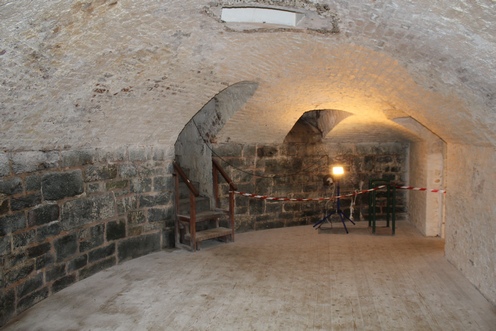
|
|
The picture on the left shows one of the first floor rooms. I
assume that this is the officer's quarters, because it has a fire
place. The black hole to the left is an air vent to let the smoke out
and some air for the fire in. The picture on the right shows the equipment store. Notice the staircase leading up the the men's quarters. The electric light is of course a luxury for which the occupants of the tower would have to wait for nearly 100 years. Torches and candles - and plenty of them - were the best they could manage in Wellington's days. |
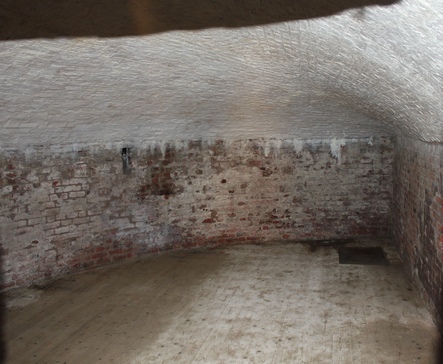 We finish with a look at what I took to be the powder store. We finish with a look at what I took to be the powder store. The renovation of this tower was very well done though the signposting leaves a lot to be desired. It is a pity that this splendid edifice is not open all the time. It would be the ideal place for the display of some mementos of the peninsular war and of the people who fought it. |
|
Return
to history
page
|
Back to the start

|
Continue with
next page
|